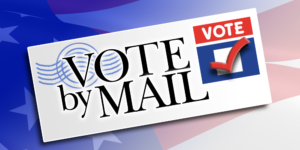Water is wet, the sun rises in the east, voter suppression laws disproportionately affect voters of color.
Alice Yi of Austin is frustrated when she thinks about the March primary election, when her 92-year-old father tried to vote by mail, as he had many times before, but couldn’t.
He could not remember what identification number he used to register to vote more than 30 years ago, she said. When he sent in his ballot application with the last four digits of his Social Security number, a rejection letter from the elections office said that number was not on file. Another letter later said her father, who is legally blind in one eye, failed to fill out other details, such as specifying which ballot he needed.
By the third attempt, Yi, his caregiver, worried her father’s application would not make it before the deadline and he would be unable to cast a ballot. So she took him to vote in person, for the first time in years.
Yi’s father was just one of thousands of Texans who attempted to vote by mail in the March primary, but collided with the Texas’ GOP restrictive 2021 voting law, known as Senate Bill 1. When voting by mail, the new law requires voters to write their driver’s license, personal identification number, or the last four digits of their Social Security number on their mail ballot application and mail ballot envelope — whichever number they originally used to register.
In fact, the mail-in applications and ballots of Asian, Latino, and Black Texans were rejected because of the new ID requirement at much higher rates than those of white voters, according to a study released Thursday by the Brennan Center for Justice, a nonpartisan law and policy institute. The office of the secretary of state declined to comment on the findings, citing pending litigation over SB 1.
Although researchers couldn’t determine the exact cause of the disparities, experts and advocates say that in addition to the voting law’s restrictions, existing factors rooted in systemic racism, such as lack of resources in their native language and other socioeconomic barriers, likely played a role in the high rejection rates.
In the March primary, 12,000 absentee ballot applications and more than 24,000 mail ballots were rejected, leading to a 12% rejection rate statewide. That represented a significant increase compared to previous years. For example, the rejection rate for the 2020 presidential election was 1%.
The study shows the rejection rate was highest for Asian voters, who were about 40% more likely to have their absentee ballot application rejected than white voters.
The study also shows that Asian and Latino voters were each more than 50% more likely than white voters to have a ballot rejected due to a problem meeting SB 1’s new requirements.
Overall, 19% of Asian voters had either their application or their mail ballot rejected due to SB1’s provisions, followed by 16.6% of Black voters and 16.1% of Latino voters. For white voters, it was 12%.
“This shows that even if you successfully applied to vote by mail, you still weren’t out of the woods, you still might have your ballot rejected,” said Kevin Morris, a researcher with the Brennan Center for Justice and one of the authors of the study. “And not only do we see this gauntlet effect happening, we see that there are big racial discrepancies in whose applications and whose ballots are rejected.”
[…]
Absentee ballot rejection rates have been lower in Texas’s smaller elections since the March primary. The mail ballot rejection rate was at 5% for the May 7 Constitutional Amendment election, according to the secretary of state’s office. For the May 24 primary runoff elections, the statewide mail ballot rejection rate across both the Republican and Democratic primaries was 3.9%. Both of those elections, however, drew only a fraction of the voters who cast ballots in the primary.
Efforts made by local election officials across Texas counties contributed to the decrease in rejections.
The study, which has some limitations that are noted in the story, is new but its findings are no surprise. I’ve said before that I’m hopeful that the error rate will continue to fall, mostly thanks to the overburdened but very hard working local officials who have done all the work to make that rejection rate go down. I’ve also now had the experience of navigating this with my elder daughter, who is voting by mail from college. I’ll be keeping track of its progress on the Harris County elections webpage. She has a couple of friends who are in college in Texas but outside the county, and I’ve advised her to tell them to just drive in and vote in person during the EV period. It’s kind of crazy, but that’s the less risky option. Hopefully that will not be the case someday.


I could have asked for a mail in ballot for last spring’s primary. I was recovering from foot surgery and unable to drive for 2 months. But I was worried about running into the same sorts of issues as Alice Yi’s father. I got a friend to drive me to the polls on Election Day.
Yeah, this study has some limitations. Numbers are often used to suit the story that the teller wants to tell. Of course when you send something in the mail they can’t tell your race.